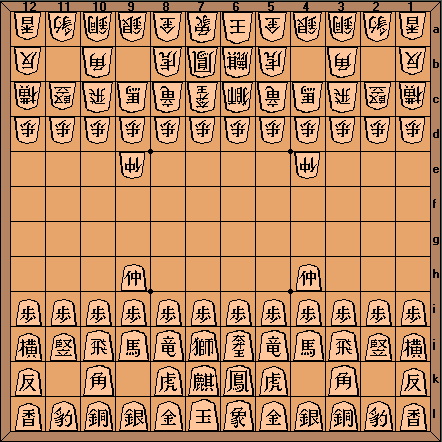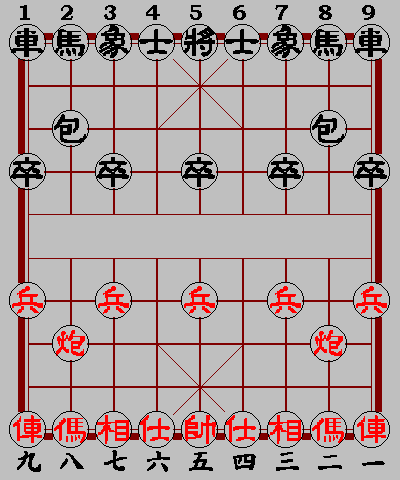There is a wealth of modern and ancient variations of the Japanese Chess family with at least 18 games from as early as 8th century AC. Steve Evans' Shogi Variants V.1.55 (1998) runs under Windows 3.11 or 95/98 and features concise and clearly laid out help screens for the original game (available here, 381 kB) and all variants (download from the author), and it is accompanied by historical remarks to each of the versions. Even experienced players will value it and be fascinated by its support in playing more ancient and complicated versions on boards of up to 25 by 25 squares with more than 100 different pieces moving or jumping according to complicated rules. Available und computer-playable versions are as follows:
800 to 1200 AC: 1200 to 1800 AC:
1200 to 1800 AC:
 1800 to 2000 AC:
1800 to 2000 AC:

Makruk mostly resembles Western Chess with a board of 8 x 8 squares, 16 similar pieces for each player, with the difference that the pawns are placed one step ahead of normal and the positions of the white king and queen are reversed. Its 3D-pieces may be an attractive alternative for the Western set of pieces, since the pawns are "caury shells", the rooks are "boats", the bishops are represented by "masks" from classical Thai royal drama and the queen is depicted as a "fruitstone" like the kerner of a cherry. Kings are named "Khun", the lowest rank of conferred nobility in the Siamese court system.
Chussana Pin-Ngoen's Thai Chess V.2.2 needs EMS memory specified in the config.sys file in order to run in a DOS window.
N. Honda's KiBKAe Thai Chess V.0.048 runs under Windows, uses English menus and is playing quite strong. I apologize to the author not to be able to give him adequate credit and report copyright details, since the programme info seems to be only in Thai language, undeciferable to myself.
Xiang-Qi as well as its offspring Korean Chess (Jang-Ki) are played on a board of 9 x 10 positions, and the 2 x 16 pieces are put on the intersections of the gridlines, not within the squares. Chinese pieces are equally-sized round chips with the values indicated by Chinese characters.  Both versions share the existence of a 'fortress' = 'castle', forming a 3 x 3 court from the centre of the baseline of each players home field with additional diagonal lines like a big 'X'. The "king" (general, emperor) and the two "guards" (advisers, counsellors) are not allowed to leave the 'fortress' during the game. Chinese Chess is the least expansive in strategy compared to all Chess variants, since there is a river between the two camps, which cannot be traversed by the king, the guards and the "prime ministers" (red side) or "elephants" (black side) respectively (bishops in Western Chess), which move only 2 steps diagonally. However, unlimited pieces are the "chariots" (rooks, cars, tanks), the "horses" (knights) and the far-reaching "cannons" (catapults) that start in the third row on either side. The latter can jump to any free position along a straight line behind an own or an opponent piece, or capture the piece encountered on the landing position. The five equally spaced "pawns" (foot soldiers) in the 4th rows have different names on either side. When having traversed the river they gain the capability to move sideways. The king, although enclosed in his 'fortress', may function to checkmate the opponent. The party, who causes the two kings to meet face to face with no intervening pieces in between, loses the game.
Both versions share the existence of a 'fortress' = 'castle', forming a 3 x 3 court from the centre of the baseline of each players home field with additional diagonal lines like a big 'X'. The "king" (general, emperor) and the two "guards" (advisers, counsellors) are not allowed to leave the 'fortress' during the game. Chinese Chess is the least expansive in strategy compared to all Chess variants, since there is a river between the two camps, which cannot be traversed by the king, the guards and the "prime ministers" (red side) or "elephants" (black side) respectively (bishops in Western Chess), which move only 2 steps diagonally. However, unlimited pieces are the "chariots" (rooks, cars, tanks), the "horses" (knights) and the far-reaching "cannons" (catapults) that start in the third row on either side. The latter can jump to any free position along a straight line behind an own or an opponent piece, or capture the piece encountered on the landing position. The five equally spaced "pawns" (foot soldiers) in the 4th rows have different names on either side. When having traversed the river they gain the capability to move sideways. The king, although enclosed in his 'fortress', may function to checkmate the opponent. The party, who causes the two kings to meet face to face with no intervening pieces in between, loses the game.
Shenjun Wu's Chinese Chess V.1.0 (1994) is available in an English menu version. The full programme features a setup function to define arbitrary starting positions or handicaps, and a commented practising mode which keeps track of the player's performance to offer problems of adequate complexity and to adjust its playing power. It runs under Windows 3.1 or 95/98.
Jang-Ki pieces are of octagonal shape and different diameter according to the power and status. Their colours are a little bit showy with red versus blue or green. The inscription of the red pieces is identical to the Chinese version, but the four big types of blue or green pieces including the "elephants" bear a more roundish and simplified brush-script style Chinese calligraphy. Note that they move freely back and forth, as there is no river and no promotion or barrier concept in Korean Chess. The red team is named "Han" and the blue or green team "Cho", as is inscribed on the king pieces. These are names of two dynasties that once were at war with each other. In the setup each player has the option to exchange the position of an adjacent pair of horse and elephant (Pozin change) on the left or right or both sides. The "horses" (knights) require a clear passage in their steps. "Elephants" (bishops) move like giant horses, one step horizontally or vertically, and two outward steps diagonally, also requiring clear passage. The Korean "cannons" can only jump over a non-cannon piece and cannot capture a cannon. Korean pawns always move one step along any line, but not backwards. Unlike in Chinese Chess, facing of the kings (from within the fortress) may be a desperate last-chance move, with which you irreversably forsake the right to checkmate the opponent, but in the hope of a later stalemate.
Note that they move freely back and forth, as there is no river and no promotion or barrier concept in Korean Chess. The red team is named "Han" and the blue or green team "Cho", as is inscribed on the king pieces. These are names of two dynasties that once were at war with each other. In the setup each player has the option to exchange the position of an adjacent pair of horse and elephant (Pozin change) on the left or right or both sides. The "horses" (knights) require a clear passage in their steps. "Elephants" (bishops) move like giant horses, one step horizontally or vertically, and two outward steps diagonally, also requiring clear passage. The Korean "cannons" can only jump over a non-cannon piece and cannot capture a cannon. Korean pawns always move one step along any line, but not backwards. Unlike in Chinese Chess, facing of the kings (from within the fortress) may be a desperate last-chance move, with which you irreversably forsake the right to checkmate the opponent, but in the hope of a later stalemate.
Hak Jong Lee's Jang-Ki V.1.0 (1991) is an English menu DOS programm also available from here (99 kB) and accompanied by an introduction to the rules from Roleigh Martin.
Kim Taehoon's Bada Janggi V.1.6 (1994) is a Korean menu Windows programm also available from here (142 kB); the menu is not displayed correctly with Western Windows versions, even if IME is installed, but it is easy enough to play it intuitively.
![]()
Bernhard Haug |